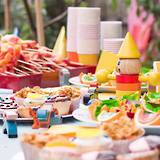Shop
01966
https://www.under5s.co.nz/shop/Hot+Topics+Articles/Food+%26+Eating/Are+kids+yoghurts+doing+more+harm+than+good.html
Are kids yoghurts doing more harm than good?
|
Many of us buy yoghurts for our kids because of the widely published health benefits they have, ranging from friendly bacteria to the amount of calcium they contain. But not all yoghurts are created equal! Some types of kids yoghurts have the same amount of sugar and additives in them as chocolate desserts! So how do you tell the difference between 'real' kids yoghurts that offer health benefits from other ‘fake’ kids yoghurts that just taste good?
|
You might also be interested in ...
5 Tips on eating out with young kids
Eating out with young kids can sometimes be a challenge, but don't let that stop you. These tips on eating out with toddlers and preschoolers will help make going to a café or restaurant a more enjoyable experience for you and the whole family.
Party food tips for toddlers & preschoolers
Not sure where to start when it comes to serving party food for toddlers and preschoolers? Here are a few easy tips you can use next time your organising their birthday party.
join usJoin us on social media for all our latest news. |
sign upSign up and receive our latest newsletters. |
|







But not all yoghurts are created equal! Some types of kids yoghurts have the same amount of sugar and additives in them as chocolate desserts!
So how do you tell the difference between 'real' kids yoghurts that offer health benefits from other ‘fake’ kids yoghurts that just taste good?
Kids real yoghurts vs fake yoghurts
So what are kids real yoghurts?
Real or ‘live’ yoghurt is made from milk or milk products that are fermented by yoghurt cultures and often referred to as pro-biotics or friendly bacteria. The cultures are still active at the time of consumption.
Kids real yogurts not only contain probiotics (such as lactobacillus acidophilus), but they are started from them rather than having them added at the end.
Kids real yoghurts have many health benefits including, amongst others:
And what are kids fake yoghurts?
So when is yoghurt 'fake' or not really a healthy choice?
Fake yoghurts are often a sweet tasting treat that’s more like a dessert than yoghurt; often found in pots endorsed with kids’ favourite characters.
Kids fake yoghurts are usually no more than cow’s milk thickened with sugar, fruits and other ingredients.
Few of these types of yoghurts provide any nutritional benefit to our kids.
Manufacturers regularly add bacteria to their products, rather than making it from live cultures, to encourage us to buy their products. However the bacteria often doesn’t survive long enough in the pot to see the inside of your kids tummy.
Fake yoghurts also contain high quantities of sugar or hidden sugars which can lead to tooth decay from an early age.
Which kids yoghurts should we buy?
There are so many different types of kids yoghurt in the supermarkets these days, it’s not always an obvious choice.
Kids yoghurts come packaged in pots of all shapes and sizes and some now come in squeezable tubes or pouches.
However if you read the ingredients labels on the yoghurt pots you’ll be able to compare them and start to notice the vast differences between real yoghurts and fake yoghurts.
For instance:
More kids food articles to enjoy:
- Cows milk allergy
- When can babies eat eggs?
- Food intolerance in kids
Image source: sarahremmer.com